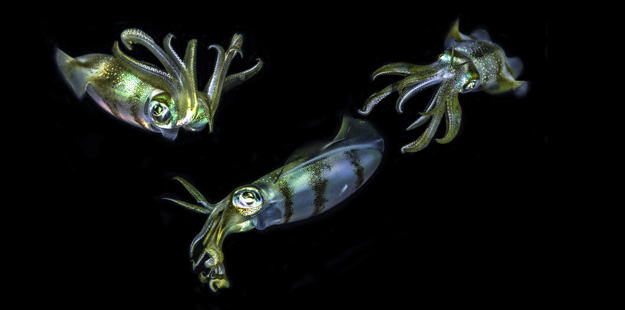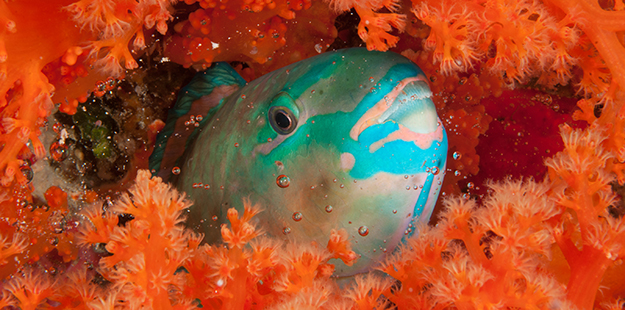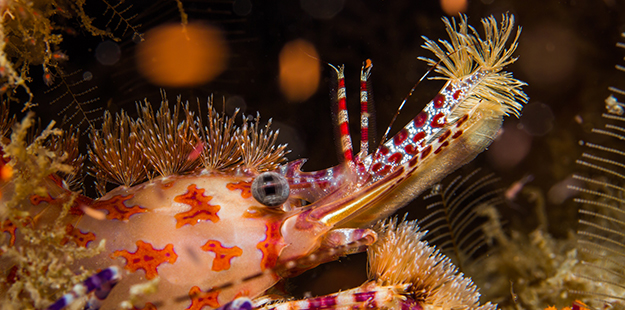Under Cover of Darkness
Discovering the rewards of night diving at Wakatobi Resort
As the sun sinks towards the western horizon, guests at Wakatobi Resort can look forward to a refreshing shower, a delicious dinner and perhaps a nightcap at the Jetty Bar. But not everyone is packing up the dive gear just yet. For some, nighttime is the right time for yet another visit to the reefs, where once-familiar landscapes are transformed by darkness, and a new cast of characters emerges. If you’re passionate about marine life, a night dive at Wakatobi Resort is definitely in order.

As species active through the day seek shelter from the darkness, nighttime foragers such as reef squid come out in full force. Photo by Wayne MacWilliams
The shift change
As sunlight wanes, the same reefs that provided hours of daytime exploration begin a transformation. Once-vivid colors become muted, and as shadows lengthen, perceptions of distance and motion are likewise diminished. Some have called this transition from daylight to darkness the “shift change,” as species active through the day seek shelter, while nighttime foragers and predators come out in full force. A quick sweep of the torch may reveal eels out and slithering through the corals, turtles napping with heads tucked into overhangs on the wall, and squadrons of squid jetting through the shadows. A swim along the reef provides a wealth of nighttime activity, and an entirely different cast of characters make an appearance on the grass beds and coral heads closer to shore.

When the sun goes down, at dive sites like Teluk Maya, nighttime creatures emerge from the shadows to feed, such as this cardinalfish and the orange tube cup corals he is swimming over. Photo by Wayne MacWilliams
At night, observant divers may find surgeonfish and other members of the day shift nestled deep into the recesses and crevices of the reef. Since fish don’t have eyelids to close, they may not appear to be asleep, but they are in fact enjoying their version of an overnight rest. Some fish do more than just bed down for the night. The spot-tail butterflyfish will actually change coloration when making the transition from day to night, morphing the attention-getting stripes of its body into a concealing black spot near the dorsal fin.

We can probably think of much better alternatives, but for the parrotfish, mucous sleeping bags are all part of a good night’s rest, and also act as an alarm system against predators. Photo by Erik Schlogl
Parrotfish perform one of the best-known bedtime rituals on the reefs. When ready to retire for the night, they secrete a clear, jelly-like mucous bubble that envelopes their entire body like a cocoon made of clear jelly. This mucous covering serves as a first line of defense by hiding the parrotfish’s scent from potential predators, as well as acting as an early warning system, should something come in contact with the cocoon’s outer layer.
Nocturnal adaptations
At the same time that all this bedding down is taking place, a very different cast of characters is emerging from hidden crevices and burrows. When the saron shrimp comes out of hiding, it undergoes a clever transformation as its body takes on shades of red that blends into the deepening shadows. After spending the day buried in soft sand, flamboyant cuttlefish emerge at dusk to hunt. These cunning, color-changing cephalopods can take on a range of vivid pink, purple, red and yellow hues and patterns that can be used for camouflage, communication or even to hypnotize potential prey. The effect can be equally hypnotic for divers fortunate enough to witness this light show.

The Saron shrimp undergoes a clever transformation as its body takes on shades of red that blend into the monochromatic shadows of the night. Photo by Wayne MacWilliams
Nocturnal reef fish have developed some unique adaptations that help them find their prey with little or no available light. The seemingly oversized orbs of the crescent-tail bigeye are highly sensitive, and not particularly tolerant of harsh sunlight. This is why, during daylight hours, you will often find them in the shadow of a wall or seeking refuge under a ledge or the mouth of a cave. After dark, the pupils of the Crescent-tail bigeye large eyes further enlarge to allow even the smallest traces of light to enter and register on the retinal fronting of the optic nerve. This allows the fish to see in almost complete darkness, and though it’s view of the world is more black and white than color, this proves ideal for detecting the indistinct outlines of prey that only come out at night.

Many nocturnal creatures emerge at dusk to congregate around the resort’s jetty, providing opportunities for unique encounters. Photo by Wayne MacWilliams
Other creatures of the night rely less on their eyes than on other senses such as touch and smell, using highly-adapted sensory receptors to pick up vibrations and even the faintest whiffs of dinner or danger. Crabs swish brush-like olfactory organs fitted with chemosensory cells to trap and sample waterborne scents. The long antenna deployed by many shrimp are used for both touch and smell as they probe for food, and remain on high alert for potential threats. Most antenna-equipped creatures use their sensors to keep their distance, but some work together. In the shallows of the House Reef, night divers may come across a school of finger-sized striped catfish, holding in a tight-knit formation while using their whisker-like barbules to maintain contact with one another.
A trip to the Zoo
While the House Reef and area around the jetty can provide endless hours of nocturnal adventure, guests will discover even more nightlife by going on one of the resort’s regularly scheduled boat dives. A favorite is the site known as Zoo, which is one of the fishiest places around Wakatobi at any time of day or night.


